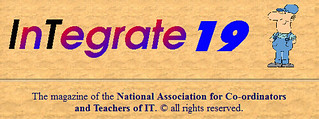Assessing Information Technology in 1995
 Just in case you thought the difficulties of assessing pupils’ attainment in Information Technology are a new thing, and how terrible Levels were (are?), I thought you might like to read a report dating from 1995.
Just in case you thought the difficulties of assessing pupils’ attainment in Information Technology are a new thing, and how terrible Levels were (are?), I thought you might like to read a report dating from 1995.
The context is as follows: the new, revised Programme of Study for Information Technology (as it was called back then) had just been unveiled. Part of the new order of things was the way in which pupils’ achievements were to be described and reported upon. Not in terms of “statements of attainment” but (shudder), Levels.
Read on to find out what teachers were not expected to do, and marvel at the fact that today some people are still giving teachers poor advice about how to determine whether or not a pupil has reached a particular level of understanding (read the bit about ticking boxes, for example).
 So much more fun than a "Level"! Photo by Wes Fryer https://www.flickr.com/photos/wfryer/
So much more fun than a "Level"! Photo by Wes Fryer https://www.flickr.com/photos/wfryer/
From InTegrate, #19, 1995. (InTegrate was the magazine of the subject association ACITT, which is now a part of Naace. Yours truly was the editor at this time.)
Assessment
There are no longer any strands to assess. Statements of attainment have been dropped in favour of Level Descriptions.One of the major flaws in the old orders was the collection of poorly structured, poorly defined, statements. The new level descriptors have been written so that they will not be out of date so quickly. They are more closely related to pupil capability rather than the capability of the software in use!
Most of the old assessment systems for IT were based on ‘potting’ statements of attainment. When enough boxes had been ticked it was judged that pupils had reached a particular level.
What is now being emphasised is the holistic nature of IT capability. Teachers will need to begin to develop a ‘feel’ for what it means to be working at a particular level. Do NOT be tempted to disassemble the level descriptors back into discrete statements or, even worse, try to construct new strands from them. A possible approach to assessment, at any key stage, is to focus on pupils following programmes of study and recording what they have achieved within them. These records will consist of pupil work such as preparatory notes, drafts produced as they progress and any final outcomes together with notes on observations made by the teacher.
Assessments in terms of levels might only be carried out once a term, or even once a year and be based on a review of the evidence gathered for each pupil.
Pupils should be encouraged to reflect on their work, either orally or by answering ‘cue’ questions such as:
- What problem were you tackling?
- What were you trying to achieve with the IT?
- How did using IT help solve the problem?
- What difficulties did you have?
- What would you do differently next time?
For more articles like this, plus news, commentary and freebies, sign up for my ezine Digital Education, for great content, longer articles, book reviews, news, comment and guest articles.